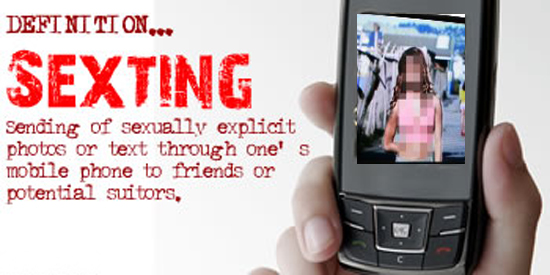What is Sexting?
According to Wikipedia Sexting is the act of sending sexually explicit messages or photographs, primarily between mobile phones.
All across the world boys and girls are using the built in cameras in their cell phones to take nude and semi-nude shots of themselves and sending them to boyfriends, friends, or classmates. Some only send the picture to a single person while others send it to dozens.
New research conducted by the University of Michigan has revealed that Sexting is now a common feature in young adult relationships today. It shows there is no psychological difference between sexters and non-sexters which contradict some reports in media stories that have claimed that sexters were anxious, depressed or had low-self-esteem. Sexting is now a normal dating ritual for teenagers and young adults.

Why can Sexting be dangerous?
Your mom probably warned you never to say anything you don’t want repeated. The same mentality holds true for Sexting. In the age of technology, things you want to keep private quickly can become available for public consumption. From text messages to photos to videos, nothing is safe. And once you put something out there, don’t even think about going back. Sexting seems like all fun and games until someone gets hurt… and that someone easily can be you, your partner or your family. It’s all too tempting to engage in sexual banter via text, instant message, email and other electronic communications. Maybe it’s with your partner, maybe it’s with someone else.
Why do youngsters Sext?
The motivation and act of sharing explicit personal photos is not new by any means. Sharing lewd photographs with other youth has been part of adolescent angst for many decades. But because of the widespread availability of mobile messaging and cell phone cameras, it has become very easy and very quick to forward explicit personal photos. Since 2008, sexting messages have become virally popular with tweens in North America and Europe.
The sexting problem lies in how easy it is to re-broadcast the photos, to the embarassment and shame of the originator. An innocuous experimental message sent to a cute boy or girl can quickly spin out of control, and the originator can become the laughing stock and shameful gossip dirt of the entire school. When a photo becomes viral online, it is virtually impossible to remove the damage and recall all the copies.
What can potentially happen next is:
- Harassment or cyberstalking: threats to share the images
- Outing: posting or sharing the images publicly
- Impersonation: pretending to be the person who created the image and posting or sharing it publicly, often with the suggestion that the person is interested in sexual contact.
And always remember that nearly a quarter of sexters have regretted pressing “send” …





2 comments